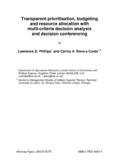Transcription of Cover the economics of pensions - LSE Research …
1 Nicholas Barr and Peter Diamond The economics of pensions Article (Accepted version) (Refereed) Original citation: Barr, Nicholas and Diamond, Peter (2006) The economics of pensions . Oxford Review of economic Policy, 22 (1). pp. 15-39 DOI: 2006 Oxford University Press This version available at: in LSE Research Online: January 2008 LSE has developed LSE Research Online so that users may access Research output of the School. Copyright and Moral Rights for the papers on this site are retained by the individual authors and/or other copyright owners. Users may download and/or print one copy of any article(s) in LSE Research Online to facilitate their private study or for non-commercial Research . You may not engage in further distribution of the material or use it for any profit-making activities or any commercial gain.
2 You may freely distribute the URL ( ) of the LSE Research Online website. This document is the author s final manuscript accepted version of the journal article, incorporating any revisions agreed during the peer review process. Some differences between this version and the published version may remain. You are advised to consult the publisher s version if you wish to cite from it. The economics of pensions Nicholas Barr and Peter Diamond January 2006 Oxford Review of economics Policy, Vol. 22. No. 1, pensions , forthcoming Draft. Not for quotation The economics of pensions1 Nicholas Barr2 and Peter Diamond3 Abstract This paper sets out the economic analytics of pensions . After introductory discussion, successive sections consider the effects of different pension arrangements on labour markets, on national savings and growth, and on the distribution of burdens and benefits.
3 These areas are controversial and politically highly salient. While open about expressing our own views, the main purpose of the paper is to set out the analytical process by which we reach them, to enable readers to form their own conclusions. 1 The backdrop This paper has a two-fold purpose. It sets out the economic analytics of pensions without discussion of empirical magnitudes and outside the context of any particular country, with the intention of giving readers a systematic way of thinking about the topic. The paper is also intended as a contribution to a continuing debate, hence part of the discussion rebuts arguments that we regard as false, or equivocal, or true in some circumstances but not necessarily always. Specifically, we argue that much analysis is incomplete and over-simplified: focussing on one objective while ignoring others; assuming an idealised economy with well-informed agents and no distortions such as taxes and missing markets; comparing one steady state with another, when the underlying issue is a move from one steady state to a different one; or ignoring distributional effects.
4 The opening section sets out some background matters: the objectives of pension systems, types of pension arrangement, and the economics of pensions . Sections 2, 3 and 4 discuss in turn pensions and labour markets (mainly microeconomic), finance and funding (mainly macroeconomic), and distributional issues. The objectives of pension systems From an individual viewpoint, income security in old age requires two types of instruments: a mechanism for consumption smoothing, and a means of insurance. 1 This paper is a shortened version of Barr and Diamond (forthcoming, Ch. 2), which is an outgrowth of our participation in a panel examining pension issues in China. We are grateful to other panel members and commentators on that report and for helpful comments on this paper from Christopher Bliss, Robert Hanck , Dieter Helm, David Hendry, Stephen Nickell and members of the OXREP editorial board at a seminar in Oxford.
5 2 Professor of Public economics , London School of economics and Political Science; Email: 3 Institute Professor, Massachusetts Institute of Technology; Email: OXREP 22/1, 2006: The theory DRAFT 4 1 Consumption smoothing People seek to maximise their well-being not at a single point in time, but over time. Someone who saves does so not because extra consumption today has no value, but because he values extra consumption in the future more highly than extra consumption today. A teenager who saves for a flight ticket is making a judgment that she will get more enjoyment from the trip than from spending the money now. Similarly, most people hope to live long enough to be able to retire. Thus a central purpose of retirement pensions is consumption smoothing a process which enables a person to transfer consumption from her productive middle years to her retired years, allowing her to choose her preferred time path of consumption over working and retired Insurance In a model of certainty, individuals save during their working life to finance their retirement.
6 Important in the case of pensions is that people face a range of uncertainties, including how long they are going to live. Thus a pension based on individual saving faces the person with the risk of outliving those savings, or of consuming very little to prevent that happening. Though any one person does not know how long he is going to live, the life expectancy of a large group of people is better known. Thus in principle, the members of the group could agree to pool their pension savings, with each person drawing a pension based on (a) the group s life expectancy and (b) the total amount he or she had contributed to the pool. In addition, members of the group could pay others to absorb the longevity risk. This is the essence of annuities, whereby an individual exchanges his pension accumulation at retirement for regular payments for the rest of his or her life, thus allowing people to insure against the risk of outliving their pension savings.
7 pension systems can also protect spouses and young children should a worker die before retirement, and can insure against disability. Are voluntary arrangements sufficient? In the simplest of all worlds a person provides for his pension through voluntary savings to achieve his optimal time path of consumption and through an annuity to protect himself (and his spouse) against the longevity risk. Were matters that simple, pensions could be left to voluntary decisions and private insurance, with no need for government involvement. There are two sets of reasons why this approach, on its own, is insufficient. First, the simple model assumes that there is perfect information (apart from date of death) and no other distortions. These assumptions are useful to formulate a simple theory, but bad guides to policy design in a world with imperfect information, missing markets, risk and uncertainty, and distortions such as progressive 4 This process is explained more formally by the simple Fisher model.
8 See, for example, Barr (2001, Ch. 2). OXREP 22/1, 2006: The theory DRAFT 4 2 taxation. Moreover, there are serious concerns about the abilities of individuals to make the most of the market opportunities available to them. The simple models, in implicitly assuming a first-best world, ignore a range of market failures, and thus assume away the very problems that government intervention is designed to address. In contrast, second-best analysis seeks the optimal policy given the presence of such distortions. A second reason for government involvement is that public policy generally has objectives additional to improving consumption smoothing and insurance, notably poverty relief and redistribution. Poverty relief Poverty relief targets resources on people who are poor on a lifetime basis, and thus unable to save enough.
9 As a practical matter, poverty relief also has to address transient poverty. Such programmes can target all the elderly or may concentrate on those who have contributed to the pension system. Redistribution pension systems can redistribute incomes on a lifetime basis, complementing the role of progressive taxes on annual income. Lifetime redistribution can be achieved by paying pensions to low earners that are a higher percentage of their previous earnings ( a higher replacement rate), thus subsidising the consumption smoothing of lower earners. Since life-long earnings are uncertain from the perspective of an individual, such a system provides some insurance against low earnings. There can also be redistribution towards families, for example paying a higher pension to a married couple than to a single person, even though both families have paid the same contributions.
10 pension systems can also redistribute across generations, for example if a government reduces the contribution rate of the present generation, thereby requiring future generations to pay higher contributions or have lower pensions . Other objectives Alongside these primary objectives, pensions policy may have secondary goals, including economic development broadly and economic growth specifically. Badly-designed pensions may create adverse labour-market incentives. Excessive public pension spending contributes to high tax rates, putting growth at risk. Conversely, pension arrangements can assist the operation of labour and capital markets and may encourage saving. There is debate about the relative weights accorded to old age security and to these secondary objectives. OXREP 22/1, 2006: The theory DRAFT 4 3 Types of pension pensions can be arranged in different ways, relating to (a) the way they are organised and (b) the relation between contributions and benefits.
















